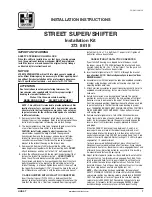
Battery
265
3
Negative terminal
4
Positive terminal
Disconnecting the battery
G
Risk of accident
If the battery is disconnected:
R
the brake boosting effect will not be avail-
able. Greater braking force will then be
required and the brake pedal travel will
be longer. If necessary, depress the
brake pedal with maximum force.
R
you will no longer be able to turn the key
in the ignition lock.
R
the selector lever is locked in position P
on vehicles with AUTOTRONIC*.
!
Always disconnect the battery in the
order described below. Never swap the ter-
minal clamps. You may otherwise damage
the vehicle electronics.
X
Apply the handbrake and shift the selector
lever to position P on vehicles with AUTO-
TRONIC*.
X
Switch off all electrical consumers.
X
Turn the key to position 0 (
Y
page 62) in
the ignition lock and remove it.
X
Remove the negative terminal clamp from
the battery.
X
Remove the cover from the positive termi-
nal clamp.
X
Remove the positive terminal clamp from
the battery.
X
Disconnect the breather hose.
Removing the battery
X
Disconnect the battery (
Y
page 265).
X
Loosen the bolt which holds the battery in
place.
X
Remove the battery.
Charging and fitting the battery
G
Risk of injury
Only charge the battery in a well-ventilated
area. As the battery is being charged, gases
can escape and generate minor explosions.
This may injure you and other persons or
cause damage to the paintwork or acid cor-
rosion on the vehicle.
You can obtain information about battery
chargers which allow the battery to be
charged when still installed from a qualified
specialist workshop, e.g. a Mercedes-Benz
Service Centre.
G
Risk of injury
There is a risk of acid burns during the
charging process due to the gases which
escape from the battery. Do not lean over
the battery during the charging process.
Practical advice
* optional
169_AKB; 2; 4, en-GB
wdomann,
Version: 2.10.6
2008-07-16T08:52:06+02:00 - Seite 265
Z
Dateiname: 6515_0315_02_buchblock.pdf;
preflight
















































